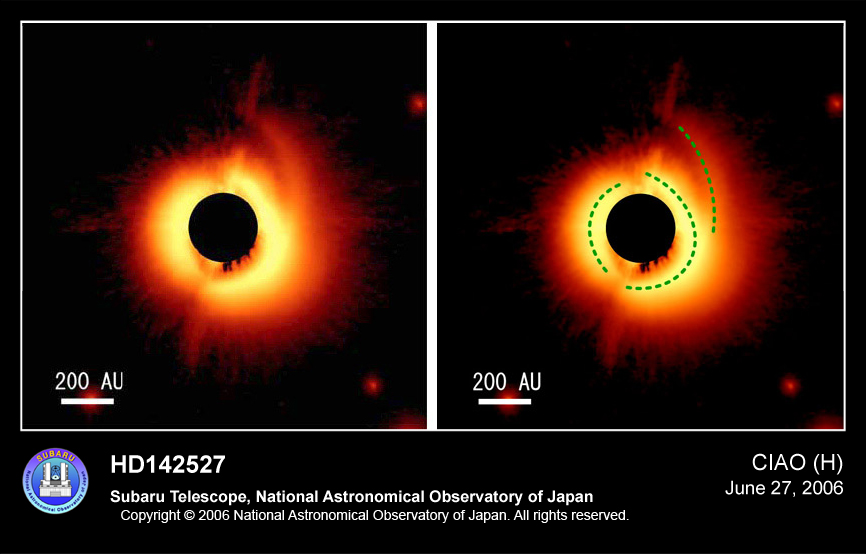
 Copyright © Michael Richmond.
This work is licensed under a Creative Commons License.
Copyright © Michael Richmond.
This work is licensed under a Creative Commons License.
You can find this talk at
http://spiff.rit.edu/richmond/asras/japan_extra/
I will try to give a brief overview of the latest developments in the study of extrasolar planets. The field is moving very fast, with new discoveries every month, and it is impossible to discuss everything in one hour. Therefore, I will concentrate on just a few of the papers which have appeared very recently and seem most interesting to me. I will try to explain some of the clever methods astronomers have devised to extract as much information as possible about these other worlds.
Contents
The most obvious method is just taking pictures, or direct imaging. Many people are developing new instruments for the near future.

With pictures of a system taken over many years, and very good measurements of position, one can look for astrometric wobble. This is very difficult, and has not yet succeeded in finding a planet.
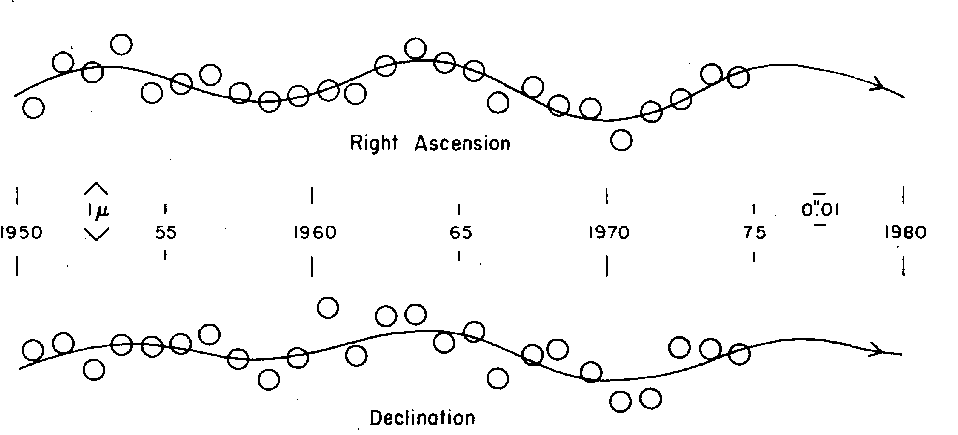
Very careful measurements of a star's radial velocity can reveal small changes due to the star's motion in response to the gravitational pull of a massive planet.
Radio astronomers can measure the times of arrival of emission from pulsars very, very precisely. Small, periodic variations in time of pulse arrival has revealed the presence of planets in a few systems.
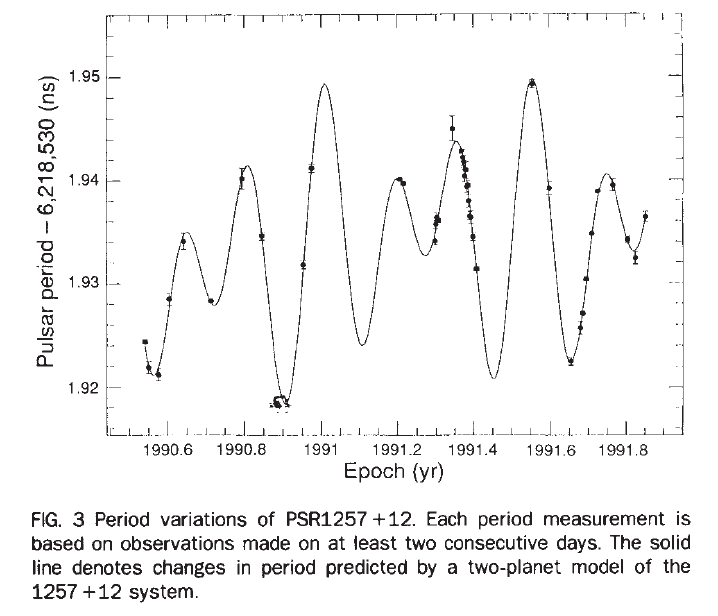
If a planet just happens to pass in front of its host star while we are watching -- as Venus does here -- then the transit dip in the light curve may show us the planet.
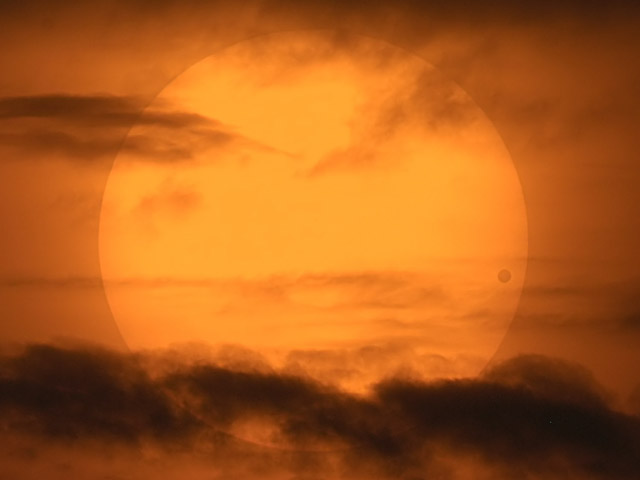
Image courtesy of David Cortner
This transit method is the easiest one, since even very small telescopes can find planets if one is very careful in the data analysis ... and patient. Right now, the transit method is HOT! so I will talk about it quite a bit.
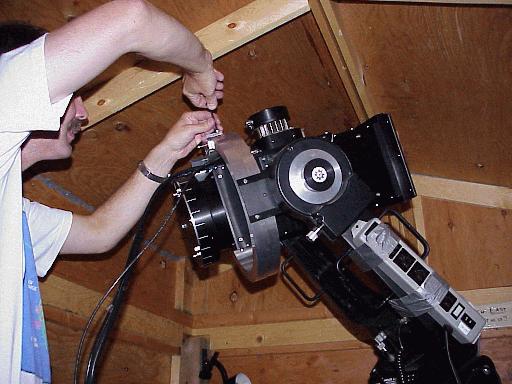
The final method I'll mention involves gravitational microlensing, which occurs when one star happens to pass almost exactly in front of a distant background star. The light of the background star is amplified in a simple, symmetric pattern ....
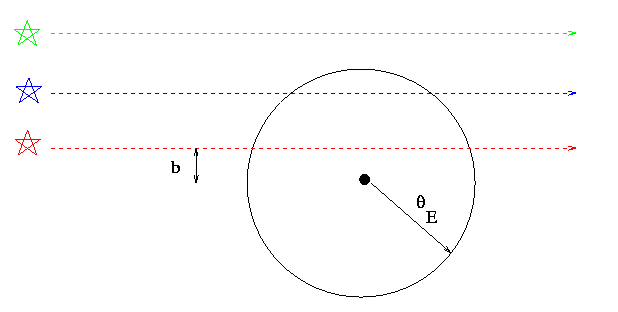
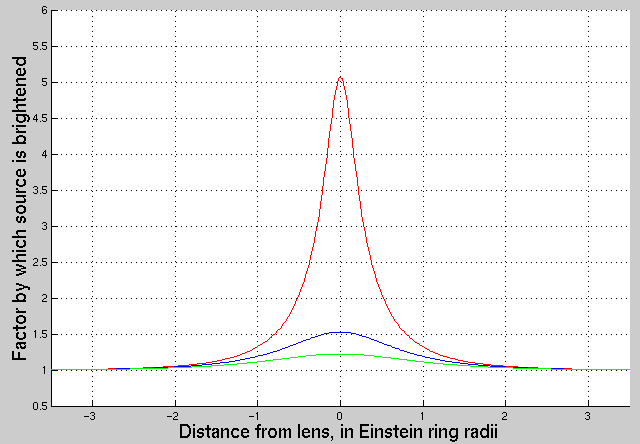
... but if the lensing system has planets, their gravitational influence can cause very sharp "spikes" in brightness.

Now, of the 287 planets known as of April 19, 2008, the great majority have been discovered by the radial velocity technique. However, notice the sharp spike in the number discovered via the transit method within the last year:
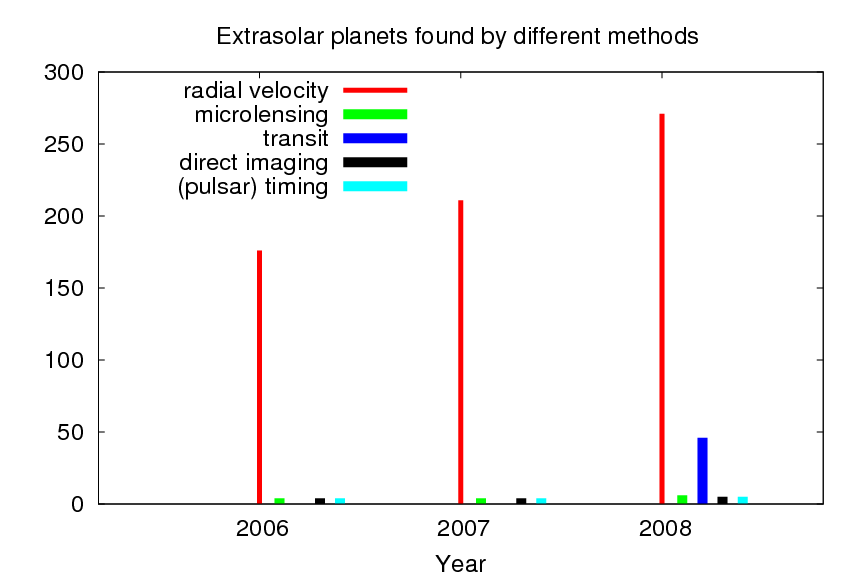
Since the transit method is so HOT! these days, I will give more time to its recent results in the following discussion.
Because the Radial Velocity searches have found the largest number of planets, they provide the strongest constraints to the question What fraction of stars have planets? This is an important quantity, especially for science-fiction writers:
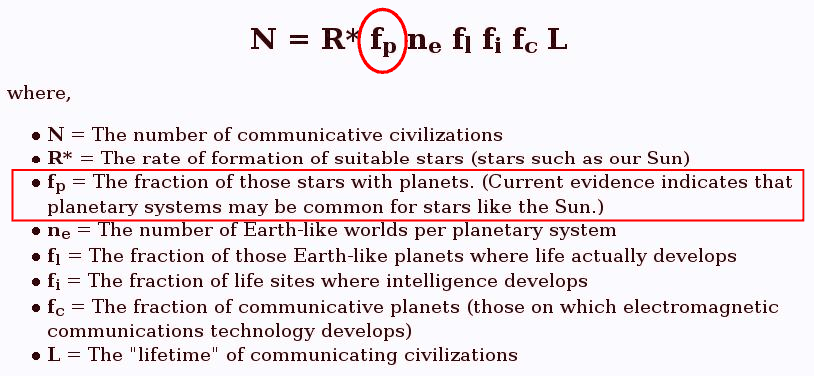
Thanks to the
Seti League for the equation.
A recent paper by Cumming et al. analyzes 8 years of effort by the Keck Planet Search team.
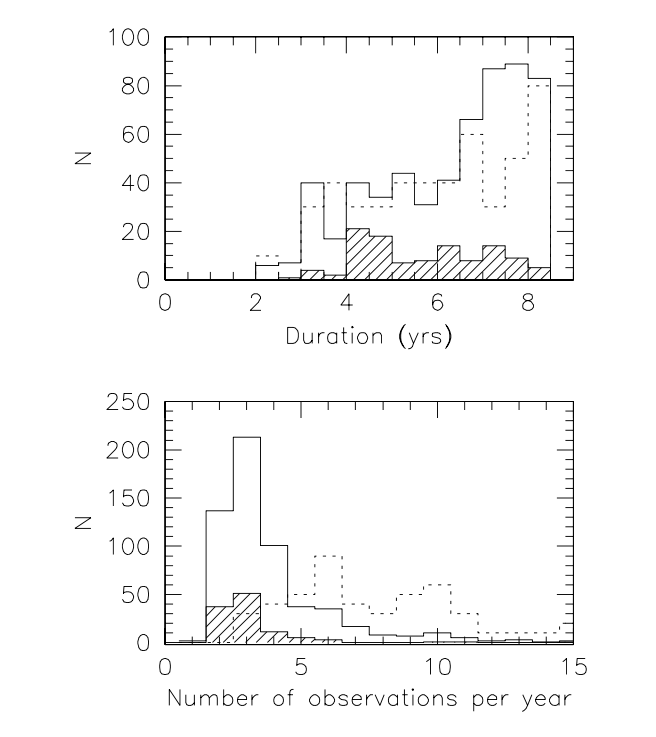
Their measurement errors are very small, typically 5 m/s or less.
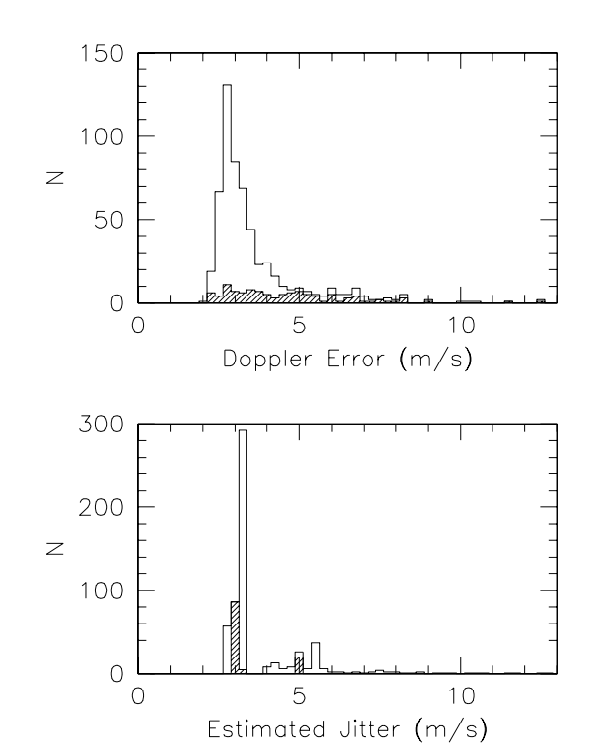
As the figure below indicates, they could easily detect a planet like Jupiter around a star like the Sun; but Saturn is the only other planet in our solar system which might fall within their sensitivity. Note how far the Earth is below their limits!
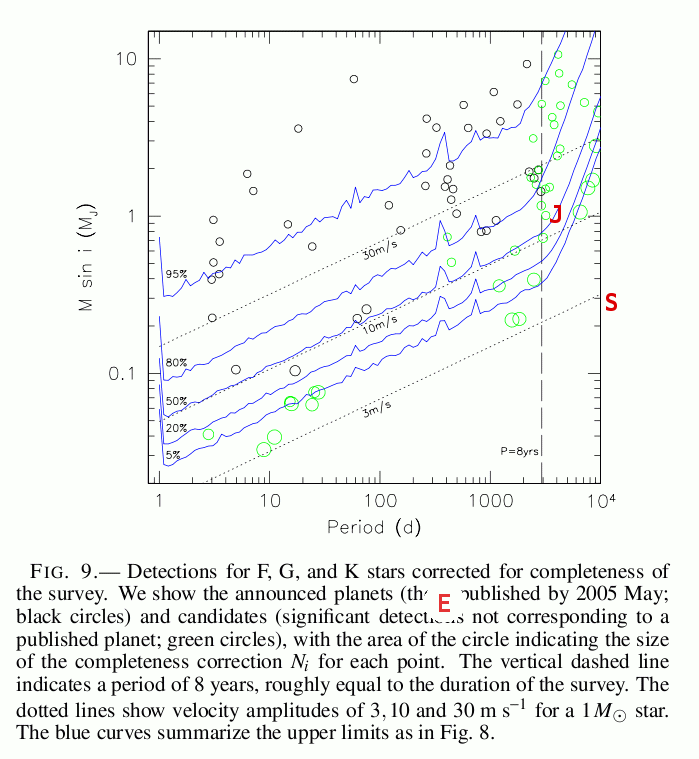
They find that most of the planets with very small orbits, the "Hot Jupiters", are in fact less massive than Jupiter. The most massive planets are most common at large orbital distances.
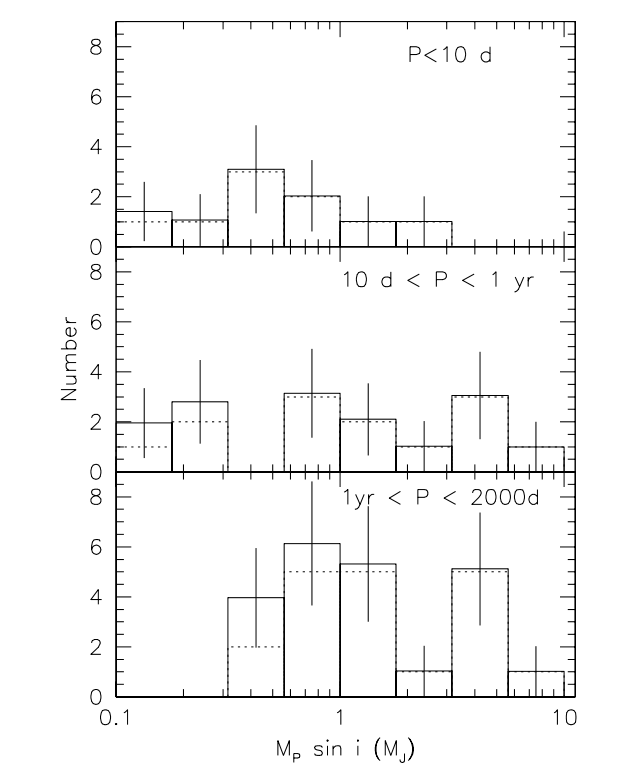
They find (among other results)
The OGLE project monitors millions of stars in the bulge of the Milky Way and in the LMC. On March 28, 2006, the OGLE team announced that one of their stars, OGLE 2006-BLG-109, was starting to brighten -- perhaps it was the beginning of a microlensing event. A large group of observers from a number of groups quickly started measuring the brightness of this star.

What they saw was a very complicated light curve: on top of the gradual, symmetric rise and fall of a normal lensing event were FIVE short, sharp spikes. The analysis was so complicated that the paper announcing the results was posted to astro-ph almost two years after the observations.
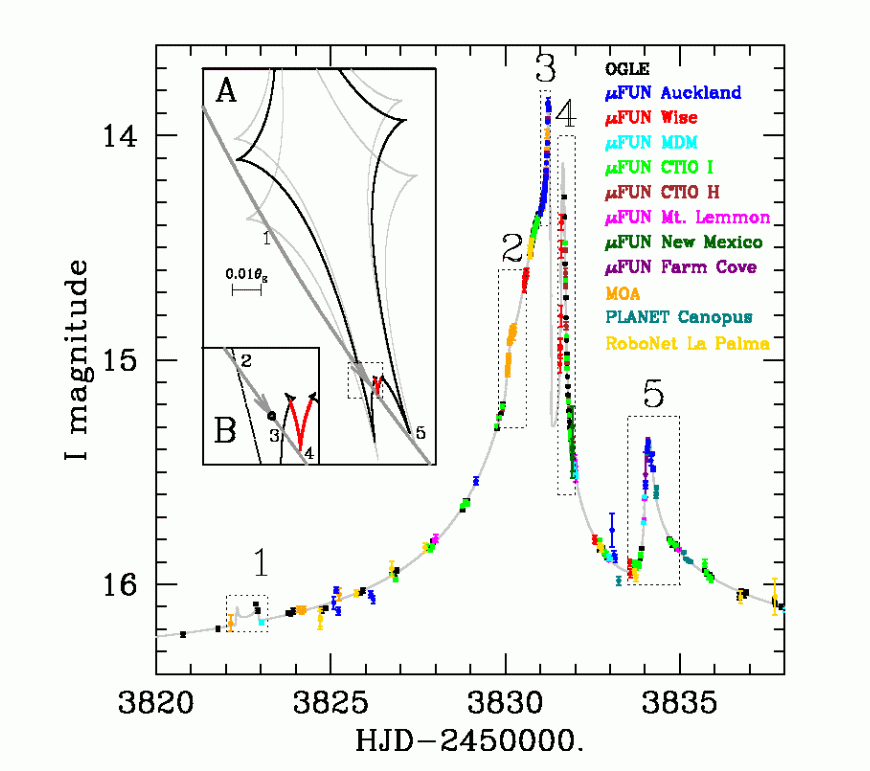
Of these five sharp features, four could be explained by a single planet, a planet with a mass roughly equal to Saturn orbiting the star at a distance of 4.6 AU. However, the fourth spike, which occurred just after the normal peak brightness, required a second planet, with a mass roughly equal to Jupiter and at a distance of about 2.3 AU.
Note the similarity to our own pair of massive planets:
Solar System OGLE 2006-BLG-109
--------------------------------------------------------------------
inner planet Jupiter Jupiter-like
mass 1.0 Mj 0.71 +/- 0.08 Mj
orbital radius 5.2 AU 2.3 +/- 0.2 AU
eq. temperature 122 82 +/- 12 K
outer planet Saturn Saturn-like
mass 0.3 Mj 0.27 +/- 0.03 Mj
orbital radius 9.6 AU 2.3 +/- 0.2 AU
eq. temperature 90 59 +/- 7 K
ratio of masses 0.30 0.37
ratio of orbital radii 0.54 0.50
--------------------------------------------------------------------
These similarities got a lot of press, as you may recall from recent newspapers and TV stories:
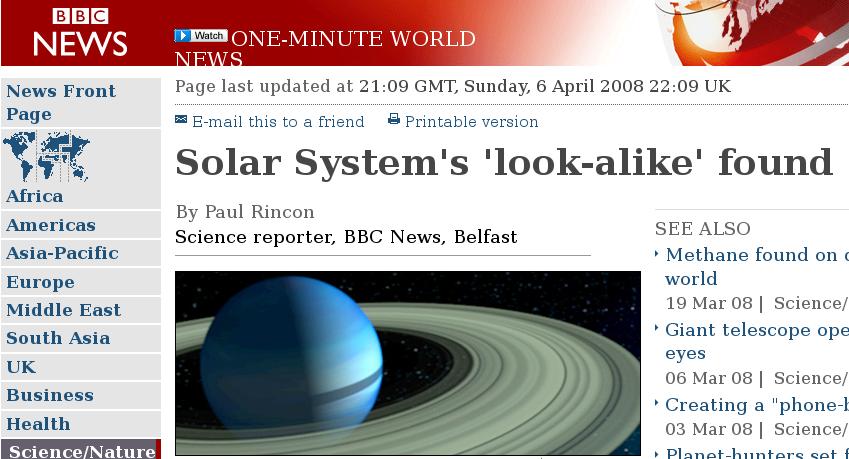
Is this system really the "twin of the Solar System?" Let's look at all the stars which host more than one planet, in this nice graph from the MicroFUN website.
Most transit searches are done with small ground-based telescopes, but there are two space missions to observe transits currently in operation. I'll talk about the MOST satellite a bit later, but now let's focus on the newer of the two. The COROT satellite, which was launched in December, 2006, carries a 14-cm off-axis telescope with a set of 4 2048x2048 CCDs, providing a field of view of about 1.3 degrees.
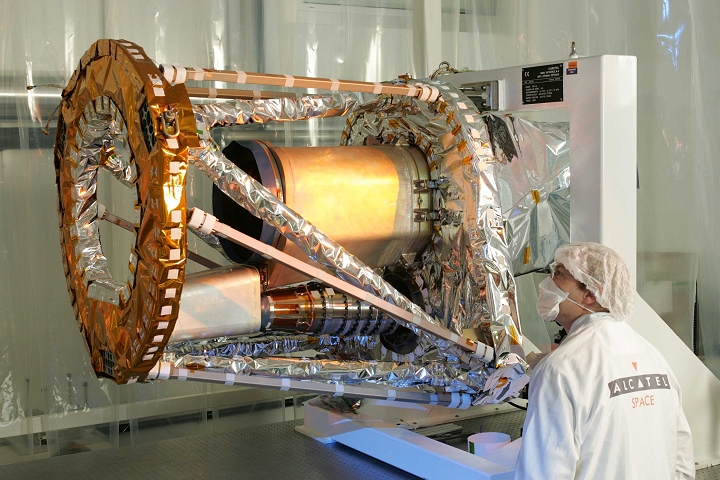
Half of the field is defocused, for asteroseismology observations; since the light from a star is spread over many pixels, the camera can accumulate a very large number of electrons without saturating. In the other half, light passes through a prism so that stars become short spectra; this allows simultaneous measurements of changes in flux at different wavelengths, to distinguish the dip due to a transit (same at all wavelengths) from a decrease due to spots or stellar variability (different depths at different wavelengths).
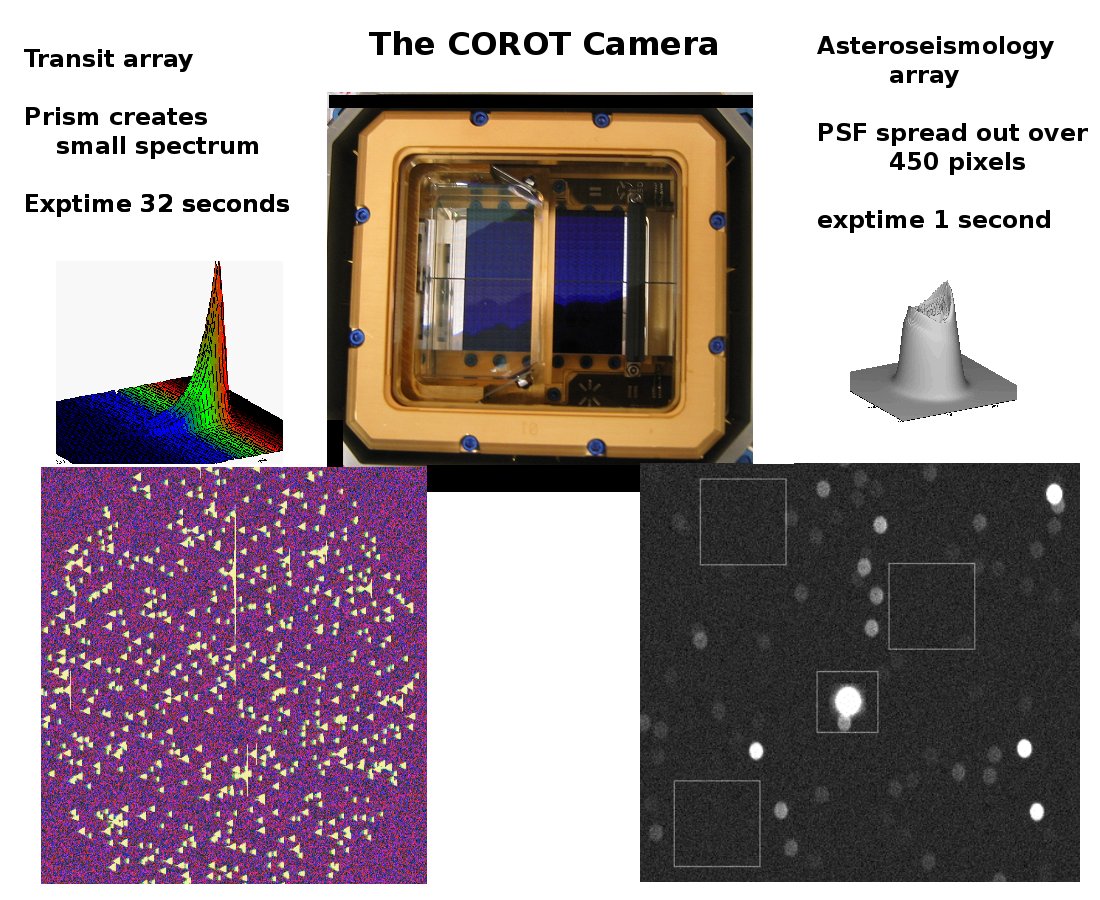
The initial science observations by COROT ran from Feb 6 to Apr 2, 2007. The first papers based on those observations have just been placed onto astro-ph. They describe two new extrasolar planets. The first is rather typical: a "Hot Jupiter" with a rather low density (0.38 gm/cc) orbiting at 0.025 AU from its star.
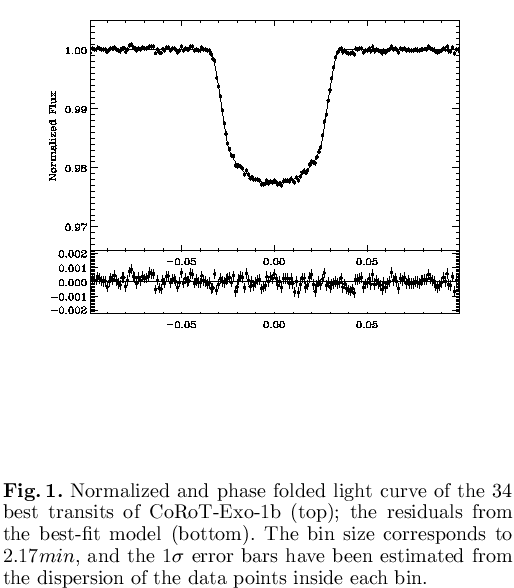
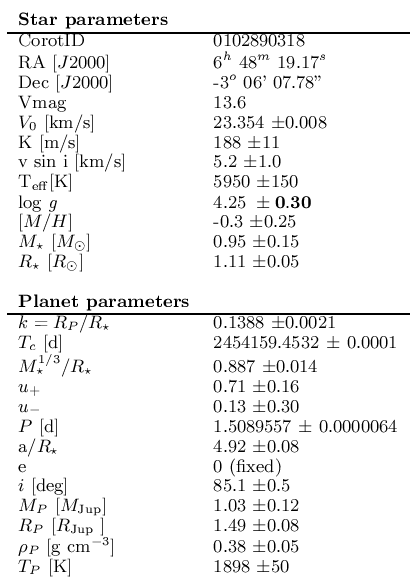
The second planet was harder to find, since its host star has large spots which cause periodic variations.
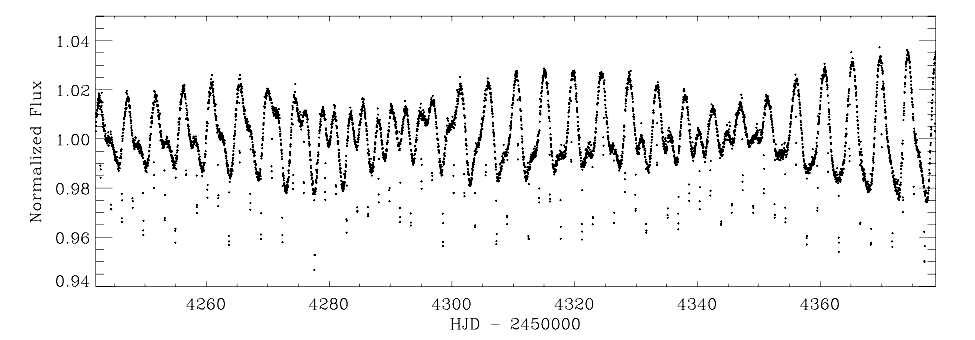
But, with some hard work, the COROT team was able to separate the stellar variations from the transits.

Ground-based spectra during a transit of this planet show changes in the apparent radial velocity of the star due to the Rossiter-McLaughlin effect:
Rossiter-McLaughlin Effect: When a planet passes in front of a spinning star, it blocks a portion of the star which has some particular radial velocity ... thus changing the overall measured radial velocity of the star.
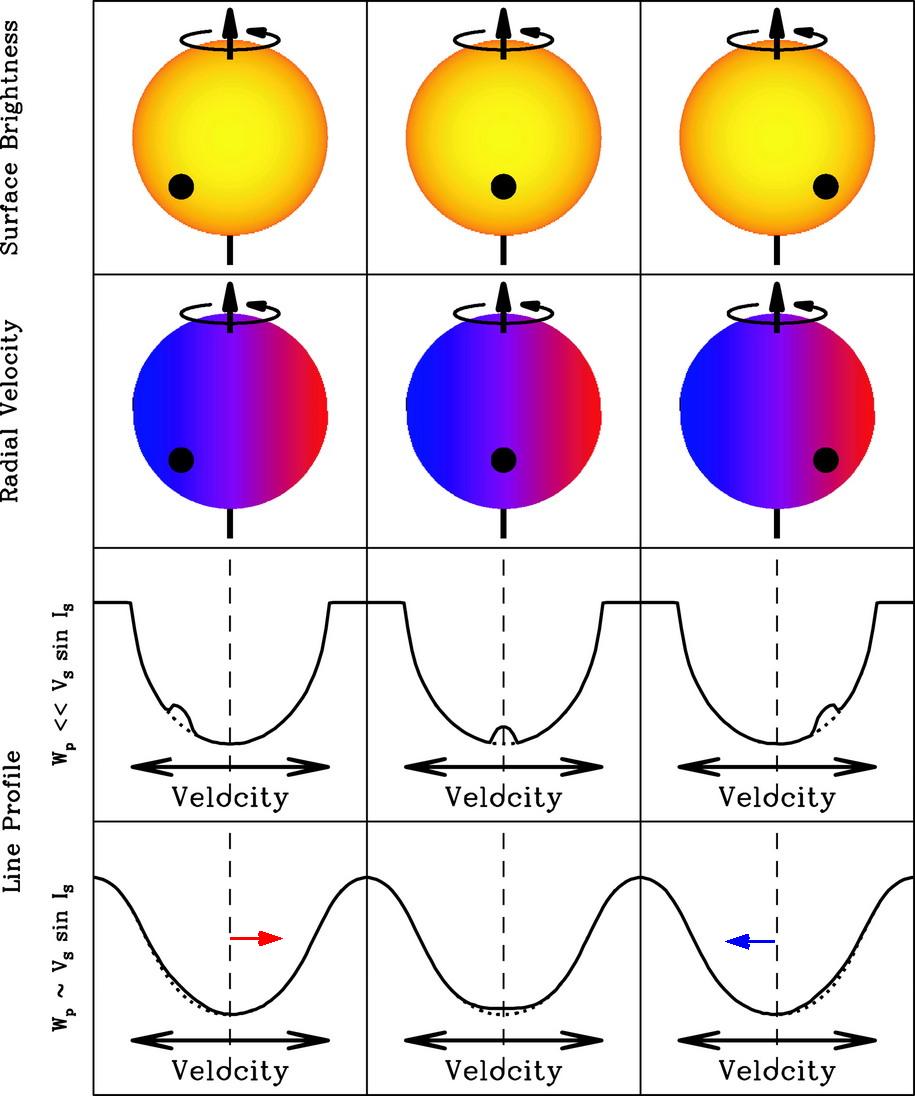
These measurements confirm that the apparent transit really is due to a planet (not another star or varying background object), and place constraints on the angle between the stellar spin axis and the planet's orbital axis; in this case, 7.2 +/- 4.5 degrees, or very nearly the same.

Different groups have measured the Rossiter-McLaughlin effect on seven planets.
In all seven cases, the planet's orbit is prograde.
In other words, the planet orbits in the same direction that its host star spins. In six of the seven systems, the angle between the orbital axis and stellar rotation axis is less than 30 degrees; but in the case of HD 17156b, the axes are tilted by 62 +/- 25 degrees.
Suppose that there was another solar system very much like ours, with a star identical to the Sun and a planet identical to the Earth orbiting it at 1 AU. Could we detect that Earth-like planet with our current technology?
Let's see how three different methods would do ...

Since the best measurements today have uncertainties of about 5 m/s, the RV method would fail by a factor of about 50 to detect the Earth.

The best ground-based measurements today have uncertainties of about 0.001 mag, while the best space-based measurements have uncertainties of about 0.000 3 mag. The basic transit method would fail by a factor of about 12 for ground-based, or by a factor of 4 for space-based telescopes.

Plugging in for the masses of the Earth and Jupiter (1 and 318, respectively), the period of the Earth's orbit (365 days), and the equatorial rotation speed of the Sun (2 km/s), we end up with

Now, it is true that this method would also fail to allow us to find another Earth orbiting another Sun, but only by a factor of 10 or so. Note the dependence on the mass of the planet: the Rossiter-McLaughlin method becomes more powerful than the standard radial-velocity for low-mass planets. In fact, for low-mass planets, the RM effect can be the most effective method.
For example, imagine that a planet like Earth was orbiting at 1 AU from a star which was like the Sun, but rotating more quickly, with an equatorial speed of 40 km/s. That's not crazy: a decent fraction of F stars, and even some G stars, rotate that quickly.
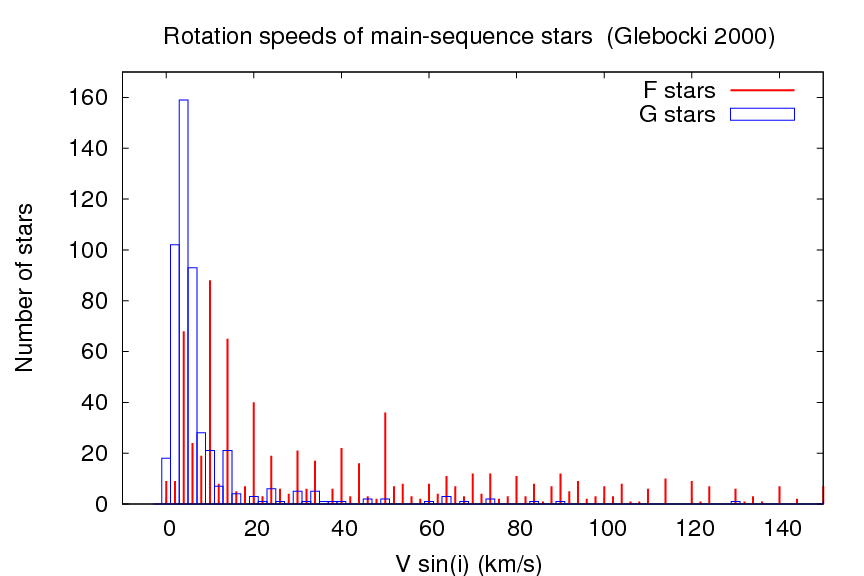
An Earth-like planet passing in front of a Sun-like star rotating at 40 km/s would induce a change in the radial velocity of about 15 m/s, which we could detect.
Transit observations of extrasolar planets are powerful in another way: we can use the motion of the transiting planet as a tool to look for other planets in the system. Under favorable circumstances, the gravitational perturbations of an unseen planet can lead to detectable changes in the times of the transits. This Transit Timing Variation (TTV) technique requires no special equipment or large telescopes, yet can be sensitive to planets of Earth-mass or lower.
Consider the measurements of the transiting planet in the HD 209458 system made by the Canadian MOST satellite. This tiny spacecraft, the size of a suitcase, is designed primarily to detect oscillations in the atmospheres of sun-like stars.
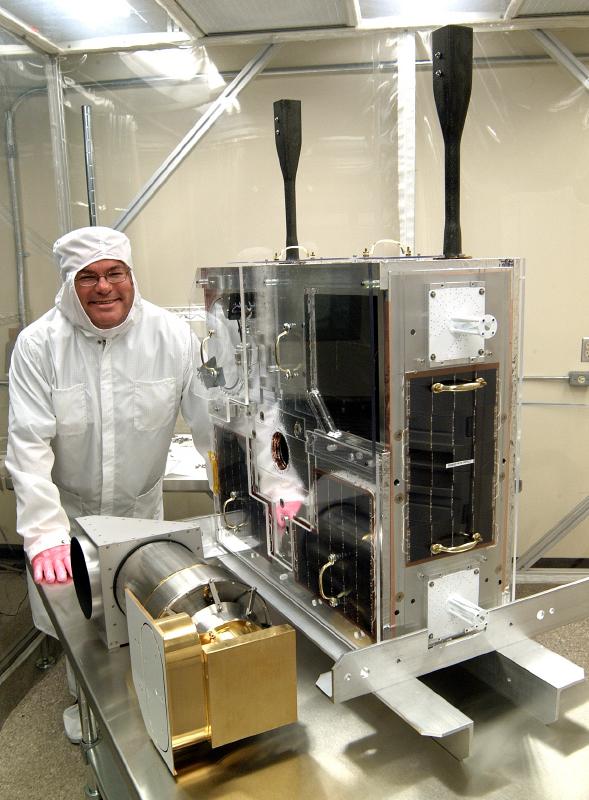
In order to collect a very large signal from bright stars, MOST -- like COROT -- spreads the light over a very large number pixels, using special Fabry microlenses in front of the CCD.
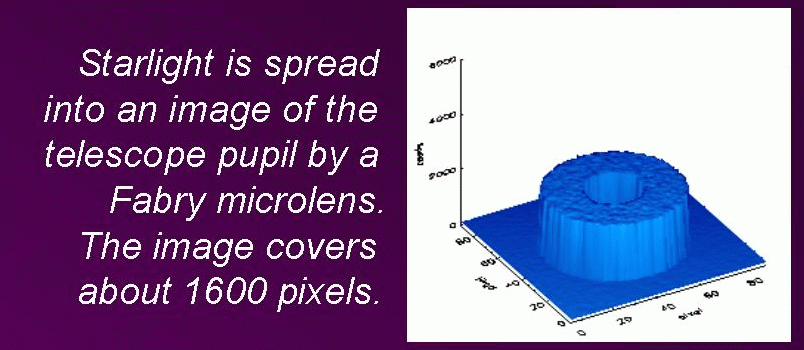
MOST stares at single targets for many days or weeks at a time to build up long time series. A recent paper describes 57 days (over two visits, one year apart) of measurements of HD 209458, the first transiting planet to be discovered.
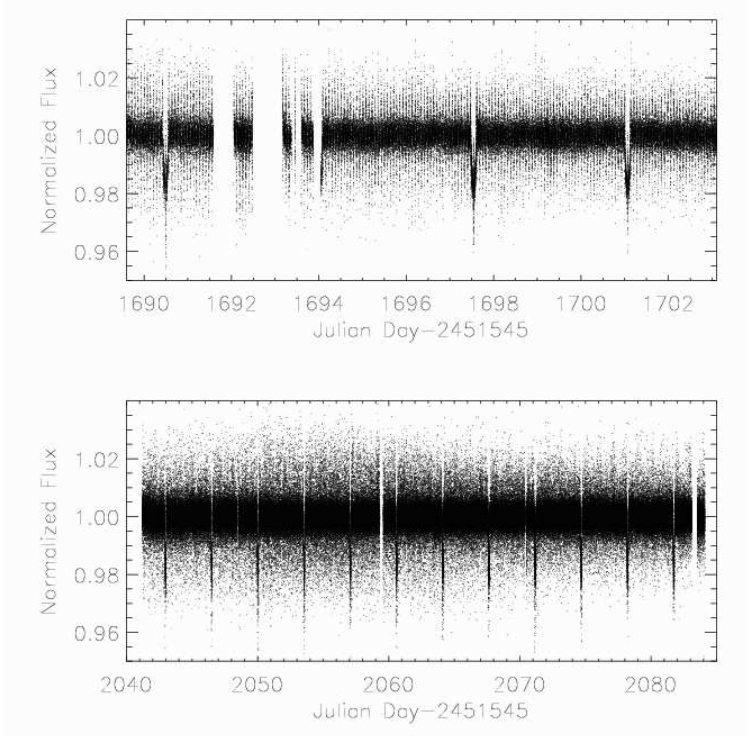
The measurements have very high photometric precision, reaching 0.000 35 magnitude. This allows precise measurements of the mid-time of each transit.


The MOST timings, combined with earlier HST timings, show no periodic variations in the motions of the transiting planet. That rules out the existence of any second planet in the system to various degrees:
at special resonances, we can rule out a planet even less massive than the Earth!
However, the limits become much weaker far from the orbital resonance locations.

In order to detect such perturbations in the times of transits, one must monitor known extrasolar planets faithfully over long periods of time, and measure very carefully the properties of each transit.
I am part of a team of astronomers, led by Holland Ford at Johns Hopkins, which is performing this kind of long-term study. We use the 0.5-meter SDSS Photometric Telescope at Apache Point, New Mexico.
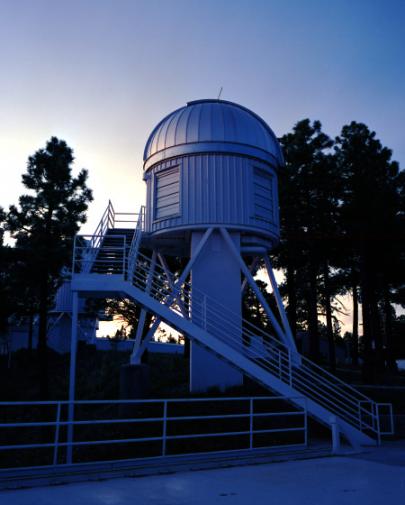
Justin Rogers (JHU) schedules the observations, choosing from a list of roughly 30 bright stars with known transiting planets. Douglas Tucker (Fermilab) makes sure that the raw data is transferred properly from the mountain to Fermilab, and runs it through the first steps of reduction. I then perform ensemble photometry on the target and other stars in the field to create a light curve of the event. You can look at my results at my transit photometry web page.
For example, the star system "XO-2" sits in the middle of a rich field. We measure the brightness of several hundred stars in each image ...
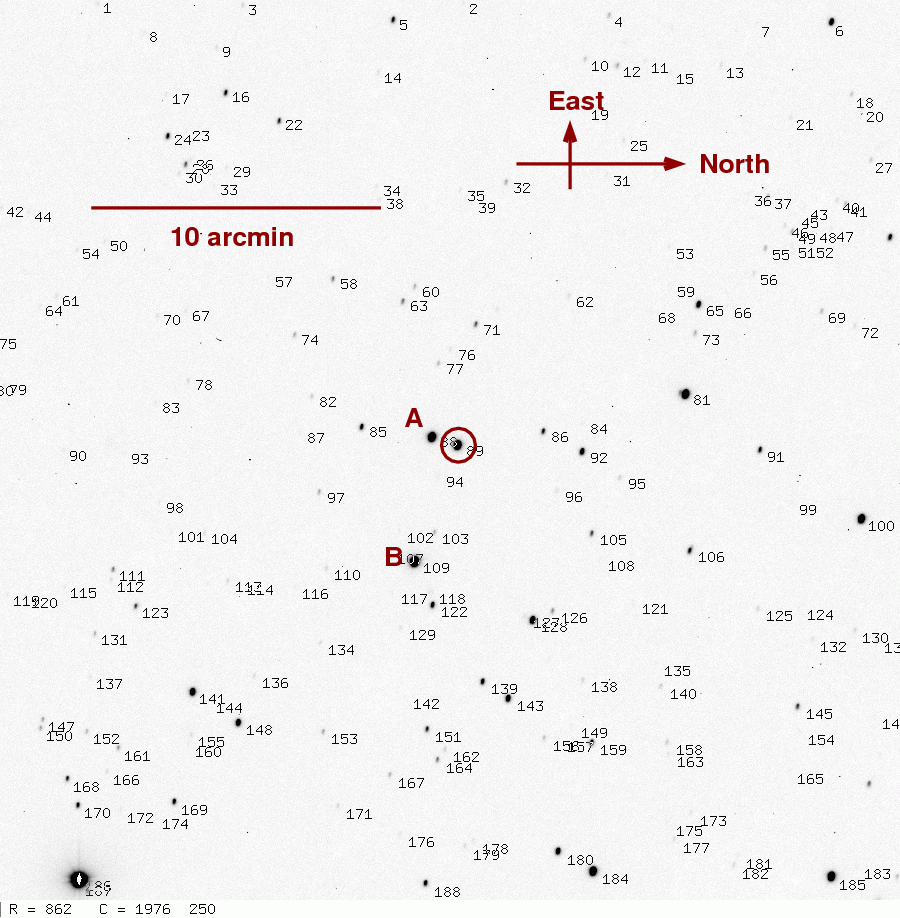
... then use the entire group to serve as a single photometric reference system. I compute the scatter of each star around its mean value. Most of the outliers at faint magnitudes are stars near the edges of the frame, or those with contaminating stars nearby. The best measurements have a precision of 0.003 mag.
Can you choose the transiting system?
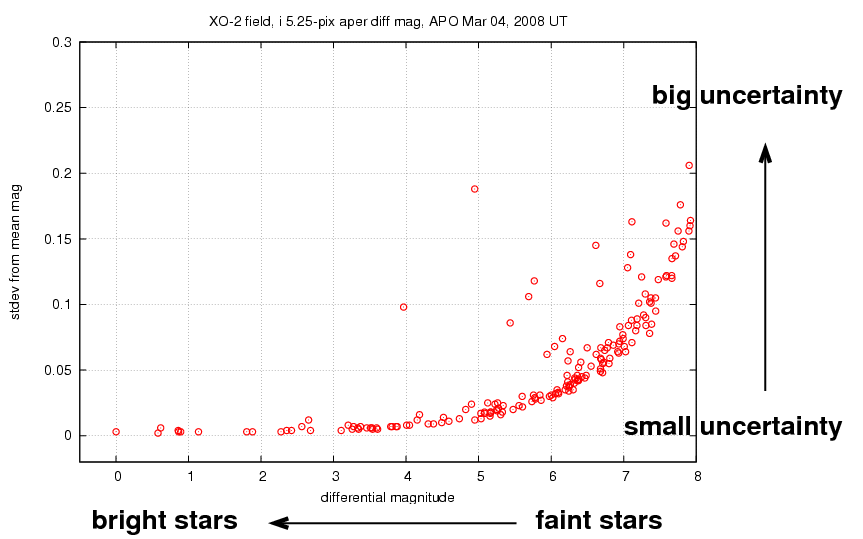
The star in "XO-2" is orbited by a planet roughly the size of Jupiter, with a period of about 2.6 days. On a good night, the PT can detect its transit cleanly, even though the depth is only 0.014 mag.
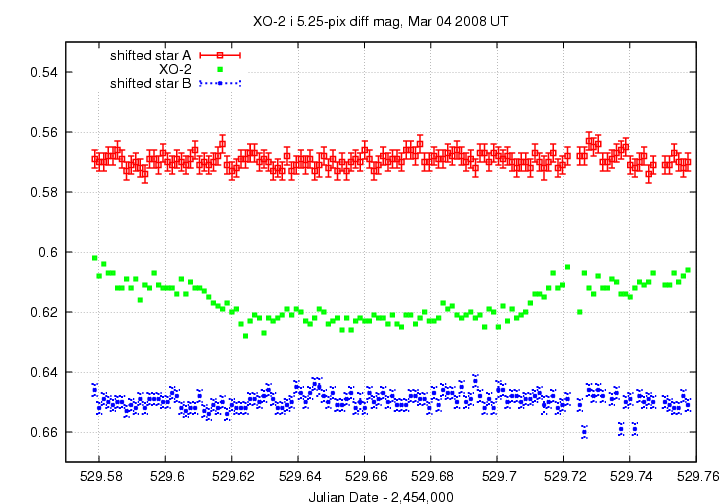
Justin Rogers is currently performing the analysis of the timing measurements for several of the planets we are watching. Here are preliminary fits to four transits by the planet TrES-3.
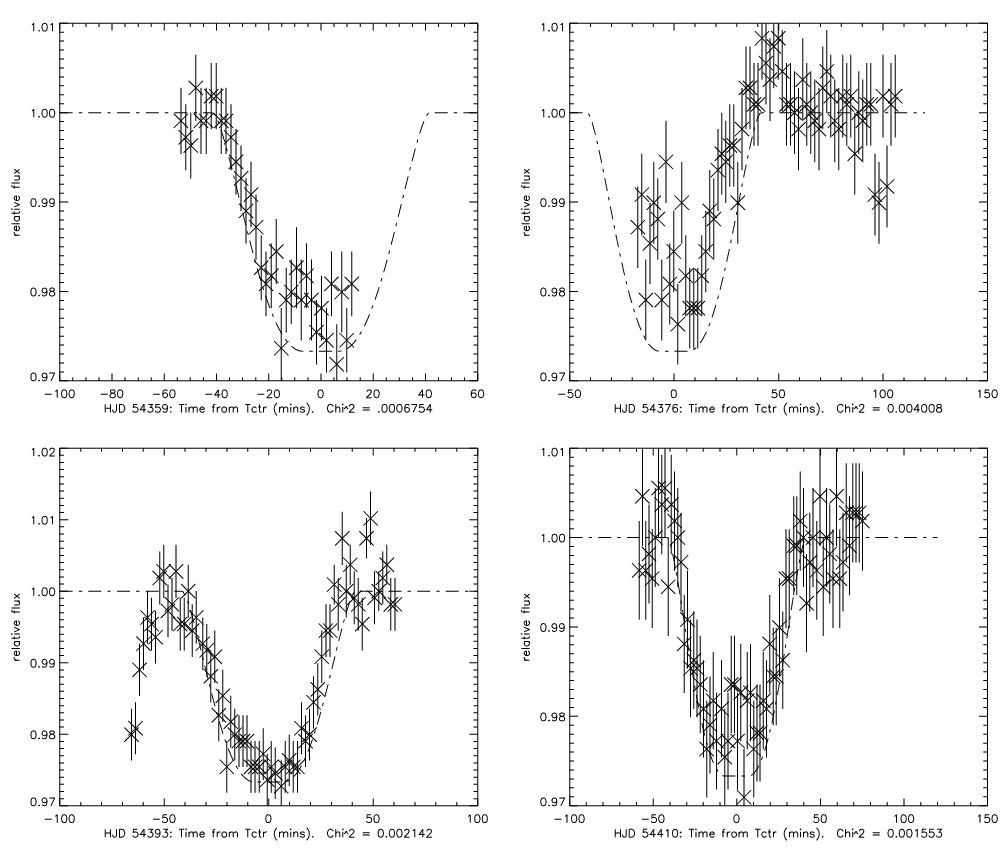
We have already noticed that in a few of the systems, the published values for transit duration are incorrect. Some of our first results will be presented at the Summer 2008 AAS meeting in St. Louis.
The planet HD 209458b is only 0.045 AU from its host star, qualifying as a "Hot Jupiter." Since the upper atmosphere must be very hot, it is possible that hydrogen might leak out of the atmosphere into space, forming an extended cloud of hydrogen around the planet. In 2003, Vidal-Madjar et al. used STIS aboard HST to detect this tenuous atomic hydrogen high in the atmosphere. They speculated that the hydrogen might be escaping to form a very extended cloud around the planet.
Can we detect a "tail" of atomic hydrogen following the planet in its orbit around the star?
Since the STIS instrument died a year ago, researchers used a prism on the ACS camera to perform slitless spectroscopy in the near-UV. They looked during the periods around two transits, hoping to see absorption of the stellar flux by this "trailing cloud" of hydrogen at the wavelength of Lyman-alpha.
The results are somewhat sketchy, due to the low signal-to-noise and small number of the measurements.
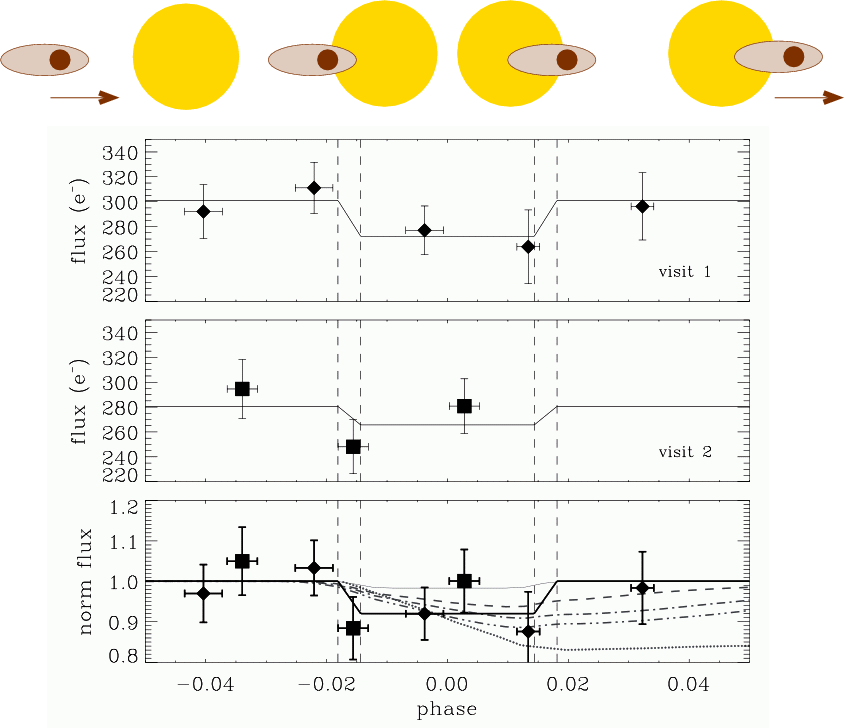
The researchers conclude that they have detected an extended envelope of hydrogen around the planet.
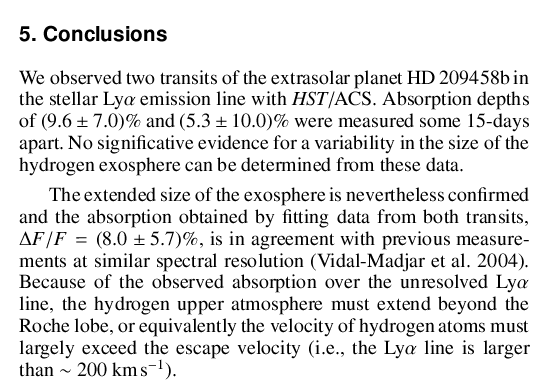
Astronomers observed the planet orbiting HD 189733 with the NICMOS-3 camera in low-resolution spectroscopy mode (via a grism), allowing measurements in the range from 1.4 to 2.5 microns. As the planet passed in front of its host star, its solid disk blocked the starlight completely at all wavelengths ...
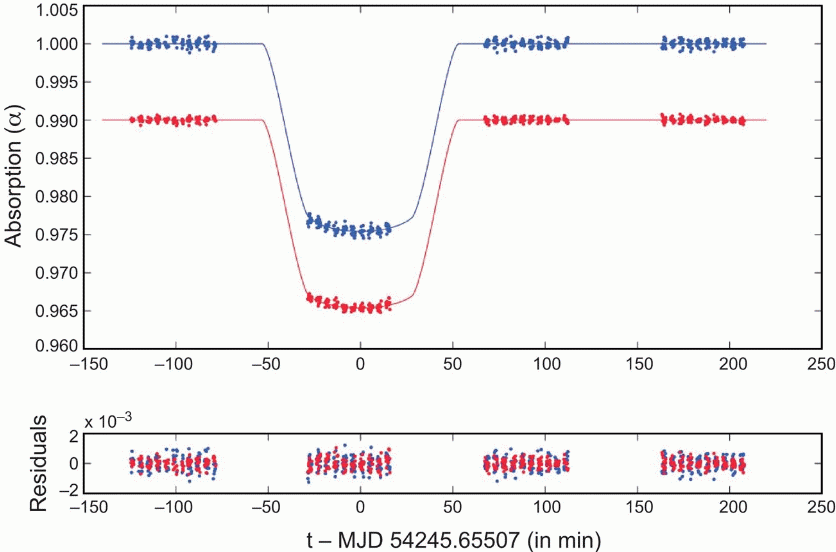
... but its atmosphere absorbed a bit of the starlight selectively: more light was absorbed at some wavelengths than others. The team was able to produce a "difference spectrum", showing the EXTRA absorption of starlight when the planet was in front of the star. Note that the graph they present is "upside down", relative to the usual convention: this graph shows absorption lines as PEAKS pointing upwards.
The difference spectrum
The planet around HD 209458 was one of the first to be found, and it has been studied intensively since then. The STIS spectrograph aboard HST measured the spectrum of the host star during the course of a transit by the planet HD 209458b, which several groups have analyzed. The latest paper in this series describes absorption of starlight by the atmosphere of the planet at visible wavelengths, concentrating on the region between 3500 and 5000 Angstroms:

The general decrease in absorption from 3500 to 5000 Angstroms (before the sodium line takes over) is attributed by the authors to Rayleigh scattering. You are probably familiar with a local example of Rayleigh scattering in an atmosphere ....

Moreover, they postulate that the main constituent of the atmosphere -- responsible for most of this scattering -- is molecular hydrogen. They use this absorption, plus information from a higher-resolution STIS spectrum discussed in an earlier paper, to derive properties of the atmosphere at the point which contributes most to the observed absorption. At this location in the atmosphere,
So, we have now detected the following species in the atmospheres of other planets:
- atomic hydrogen : HD 209458b
- molecular hydrogen (very indirectly) : HD 209458b
- atomic sodium: HD 209458b, HD 189733b
- water vapor : HD 189733b
- methane : HD 189733b
 Copyright © Michael Richmond.
This work is licensed under a Creative Commons License.
Copyright © Michael Richmond.
This work is licensed under a Creative Commons License.